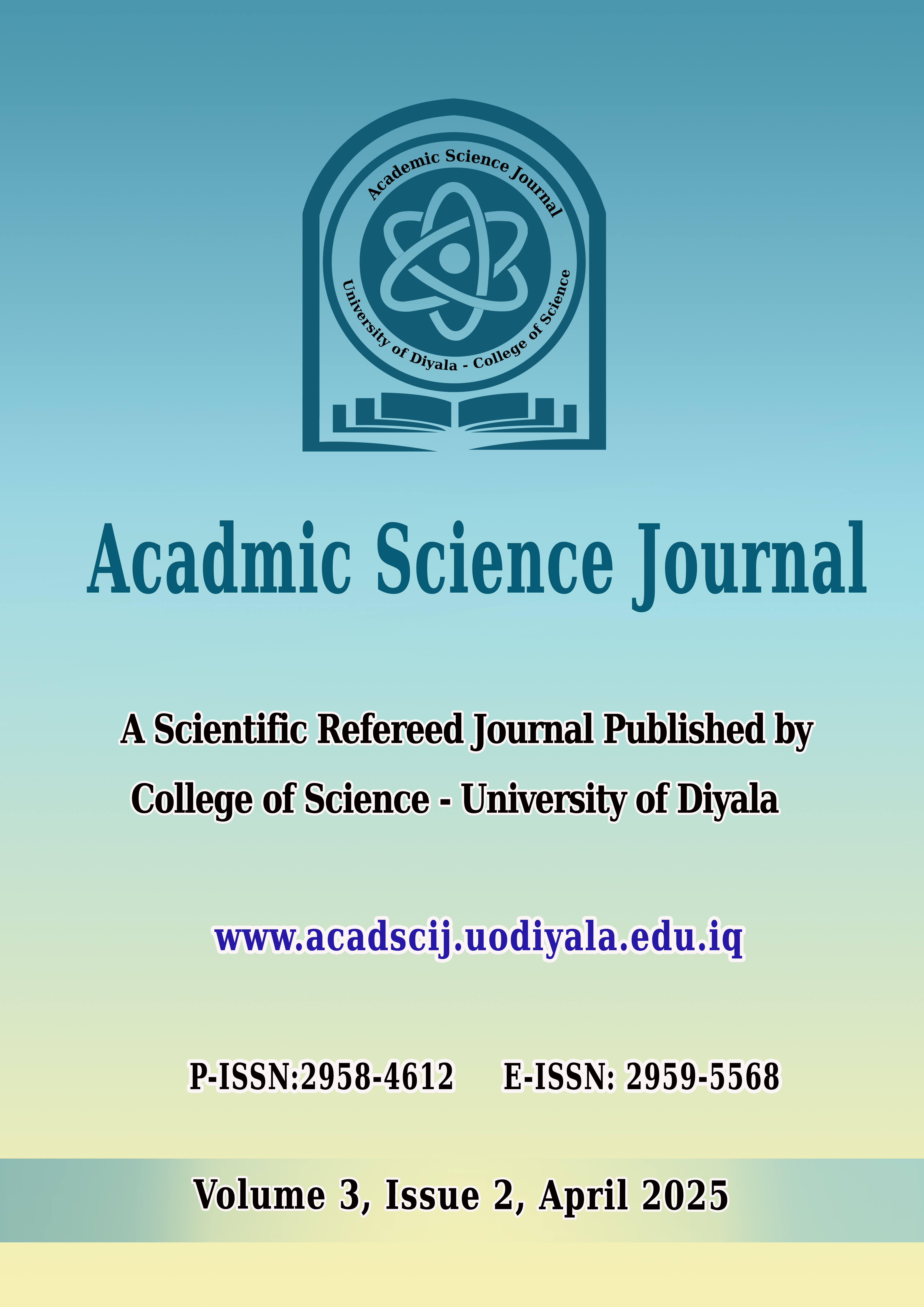Association of Blood Indices Changes with Parvovirus B19 Infection inThalassemia Patients
DOI:
https://doi.org/10.24237/ASJ.03.02.896DKeywords:
Thalassemia, Parvovirus B19, blood indices and ELISA.Abstract
Parvovirus B19 is responsible for several clinical conditions, such as infectious erythematosus, joint inflammation, fetal hydrops, and chronic hemolytic anemia resembling thalassemia syndrome, as well as transient aplastic crises. B19 can be transferred via respiratory secretions, as well as through the use of blood products and blood transfusions . This study aims to demonstrate the effect of Parvovirus B19 infection on some blood indices in Thalassemia patients. Methods: Ninety patients in the Center of Hematological Diseases of Diyala Directorate of Health were tested for anti-parvovirus B19 IgM using the ELISA technique, and then Full parameters of CBC were determined using the Urit 3000 plus automated system. Statistical analysis was done using SPSS Version 29. The results of the present study showed that the overall positivity rate of the anti-Parvo B19 IgM marker was 28(31.1%) among thalassemia patients. The results of the association of anti-parvo B19 IgM with the parameters of blood indices (Total WBCs, Lymphocytes, Granulocytes, Hemoglobin, RBCs, and Platelets count) found that the mean ± SD of the total WBC count, total lymphocytes count, total granulocytes count, hemoglobin concentration, total RBC count and platelets count in thalassemia patients who were positive for anti-parvo B19 IgM were 13.93 ± 13.08 cells/ cu.mm, 9.24 ± 12.01 cells/ cu.mm, 4.69 ± 2.46 cell/ cu.mm, 7.59 ± 1.30 gm/dl, 2.79 ± 0.54 corpuscle/ cu. Mm and 469.4 ± 284.8 platelet/ cu.mm, respectively. Parvovirus B19 is transmitted by blood transfusions. Patients with persistent anemia and hematologic illnesses like thalassemia may need ongoing blood infusions and may be given red blood cell units that contain Parvovirus B19.
Downloads
References
[1] K. Berns, C. Parrish, Parvoviridae, Fields virology, 6th ed, (Lippincott Williams & Wilkins, Philadelphia, PA. 2015), 1768–1791
[2] T. Tolfvenstam, K. Broliden, Parvovirus B19 infection, Seminars in Fetal and Neonatal Medicine, Elsevier, 2009)
[3] OE. Obeid, Molecular and serological assessment of parvovirus B19 infections among sickle cell anemia patients, The Journal of Infection in Developing Countries, 5(07),535-939(2011), DOI(https:/doi.org/10.3855/jidc.1807)
[4] D. Peterlana, A. Puccetti, R. Corrocher, C. Lunardi, Serologic and molecular detection of human Parvovirus B19 infection, Clinica chimica acta, 372(1-2),14-23(2006), DOI(https://doi.org/10.1016/j.cca.2006.04.018)
[5] JR. Kerr, A review of blood diseases and cytopenias associated with human parvovirus B19 infection, Reviews in Medical Virology, 25(4), 224-240(2015), DOI(https://doi.org/10.1002/rmv.1839)
[6] A. Pedrosa, A. Mota, P. Morais, A. Nogueira, M. Brochado, E. Fonseca, Haemophagocytic syndrome with a fatal outcome triggered by parvovirus B19 infection in the skin, Clinical and Experimental Dermatology, 39(2),222-223(2014), DOI(https://doi.org/10.1111/ced.12208)
[7] M. Mayama, M. Yoshihara, T. Kokabu, H. Oguchi, Hemophagocytic lymphohistiocytosis associated with a parvovirus B19 infection during pregnancy, Obstetrics & Gynecology, 124(2 PART 2), 438-41(2014), DOI(https://doi.org/10.1097/aog.0000000000000385)
[8] SS. Ganaie, J. Qiu, Recent advances in replication and infection of human parvovirus B19, Frontiers in cellular and infection microbiology, 8, 166(2018), DOI(https://doi.org/10.3389/fcimb.2018.00166)
[9] AV. Florea, DN. Ionescu, MF. Melhem, Parvovirus B19 infection in the immunocompromised host, Archives of Pathology & Laboratory Medicine, 131(5), 799-804(2007), DOI(https://doi.org/10.5858/2007-131-799-PBIITI)
[10] Y. Luo, J. Qiu, Human parvovirus B19: a mechanistic overview of infection and DNA replication, Future virology, 10(2), 155-167(2015), DOI(https://doi.org/10.2217/fvl.14.103)
[11] J. Bhattacharyya, R. Kumar, S. Tyagi, J. Kishore, M. Mahapatra, V. Choudhry, Human parvovirus B19-induced acquired pure amegakaryocytic thrombocytopenia, British journal of haematology, 128(1), 128-129(2005), DOI(https://doi.org/10.1111/j.1365-2141.2004.05252.x)
[12] L. Singhal, B. Mishra, A. Trehan, N. Varma, R. Marwaha, RK. Ratho, Parvovirus B19 infection in pediatric patients with hematological disorders, Journal of global infectious diseases, 5(3), 124(2013), DOI(https://doi.org/10.4103/0974-777x.116881)
[13] M. A. K. Al Atbee, H. A. Al Hmudi, S. K. A. Al Salait, Seroprevalence of human parvovirus B19 antibodies in patients with hemoglobinopathies in Basrah Province-Iraq, (2021)
[14] S. Soltani, A. Zakeri, A. Tabibzadeh, M. Zandi, E. Ershadi, S. Akhavan Rezayat, A literature review on the parvovirus B19 infection in sickle cell anemia and β-thalassemia patients, Tropical medicine and health, 48, 1-8(2020), DOI(https://doi.org/10.1186/s41182-020-00284-x)
[15] M. M. Hussein, A. S. Hasan, JI. Kadem, The Rate of Parvovirus B19 Infection among Children with Clinically Suspected Erythema Infectiosumin Diyala Province, Iraq, Annals of the Romanian Society for Cell Biology, 4212-4226(2021)
[16] A. Hasan, A. Hwaid, A. Al-Duliami, Seroprevalence 19. of anti-parvovirus B19 IgM and IgG antibodies amonge pregnant women in Diyala province, International Journal of Recent Scientific Research Research, 4(11), 1677-1681(2013)
[17] J. Kishore, D. Kishore, Clinical impact & pathogenic mechanisms of human parvovirus B19: a multiorgan disease inflictor incognito, Indian Journal of Medical Research, 148(4), 373-84(2018), DOI(https://doi.org/10.4103/ijmr.ijmr_533_18)
[18] MW. Molenaar-de Backer, V. V. Lukashov, R. S. van Binnendijk, H. J. Boot, H. L. Zaaijer, Global co-existence of two evolutionary lineages of parvovirus B19 1a, different in genome-wide synonymous positions, (2012), DOI(https://doi.org/10.1371/journal.pone.0043206)
[19] M. Thijssen, G. Khamisipour, M. Maleki, T. Devos, G. Li, M. Van Ranst, M. R. Pourkarim, Characterization of the human blood virome in Iranian multiple transfused patients, Viruses, 15(7), 1425(2023), DOI(https://doi.org/10.3390/v15071425)
[20] S. Kumar, R. M. Gupta, S. Sen, R. S. Sarkar, J. Philip, A. Kotwal, S. H. Sumathi, Seroprevalence of human parvovirus B19 in healthy blood donors, Medical journal armed forces India, 69(3), 268-272(2013), DOI(https://doi.org/10.1016/j.mjafi.2012.11.009)
[21] S. Kumar, R. Gupta, S. Sen, R. Sarkar, J. Philip, A. Kotwal, Seroprevalence of human parvovirus B19 in healthy blood donors, Medical journal armed forces India, 69(3), 268-72(2013), DOI(https://doi.org/10.1016/j.mjafi.2012.11.009)
[22] RI. Handin, SE. Lux, TP. Stossel, Blood: principles and practice of hematology, (Lippincott Williams & Wilkins, 2003)
[23] A. H. Alharbi, C. Aravinda, M. Lin, P. Venugopala, P. Reddicherla, MA. Shah, Segmentation and classification of white blood cells using the UNet, Contrast Media & Molecular Imaging, (2022), DOI(https://doi.org/10.1155/2022/5913905)
[24] RA. Omman, AR. Kini, Leukocyte development, kinetics, and functions, Keohane EM, Otto CM, Walenga JM, Rodak’s Hematology: Clinical Principles and Applications 6th edn, (Amsterdam, Netherlands: Elsevier, 2019), 117-135
[25] T. W. Guilbert, J. E. Gern, Jr. RF. Lemanske, Infections and asthma, Pediatric Allergy: Principles and Practice, 363(2010), DOI(https://doi.org/10.1016/B978-1-4377-0271-2.00035-3)
[26] L. Estcourt, S. Stanworth, C. Doree, P. Blanco, S. Hopewell, M. Trivella, Granulocyte transfusions for preventing infections in people with neutropenia or neutrophil dysfunction, Cochrane Gynaecological, Neuro-oncology and Orphan Cancer Group, editor Cochrane Database of Systematic Reviews (2015), DOI(https://doi.org/10.1002/14651858.CD005341.pub3)
[27] B. M. Ricerca, A. Di Girolamo, D. Rund, Infections in thalassemia and hemoglobinopathies: focus on therapy-related complications, Mediterranean journal of hematology and infectious diseases, 1(1), (2009), DOI(https://doi.org/10.4084/MJHID.2009.028)
[28] D. Farmakis, A. Giakoumis, E. Polymeropoulos, A. Aessopos, Pathogenetic aspects of immune deficiency associated with beta-thalassemia, Med Sci Monit, 9, 22,(2003)
[29] S. Vento, F. Cainelli, F. Cesario, Infections and thalassaemia, The Lancet infectious diseases, 6(4),226-233(2006)
[30] J. M. Sheen, F. J. Lin, Y. H. Yang, K. C. Kuo Increased non-typhoidal Salmonella hospitalizations in transfusion-naïve thalassemia children: a nationwide population-based cohort study, Pediatric research, 91(7), 1858-1863(2022), DOI(https://doi.org/10.1038/s41390-021-01602-7)
[31] M. Marziali, M. Ribersani, A. A. Losardo, F. Taglietti, P. Pugliese, A. Micozzi, A. Angeloni, COVID‐19 pneumonia and pulmonary microembolism in a patient with B‐thalassemia major, Clinical Case Reports, 8, 12, 3138-3141(2020), DOI(https://doi.org/10.1002/ccr3.3275)
[32] W. Wanachiwanawin, Infections in E-β thalassemia, Journal of pediatric hematology/oncology, 22(6), 581-587(2000)
[33] C. C. Hsia, Respiratory function of hemoglobin, New England Journal of Medicine, 338(4), 239-248(1998), DOI(https://doi.org/10.1056/nejm199801223380407)
[34] R. C. Hardison, Evolution of hemoglobin and its genes. Cold Spring Harbor perspectives in medicine, 2(12), a011627(2012)
[35] A. Kattamis, JL. Kwiatkowski, Y. Aydinok, Thalassaemia, The lancet, 399(10343), 2310-2324(2022)
[36] A. Abu-Shaheen, H. Heena, A. Nofal, D. A. Abdelmoety, A. Almatary, M. Alsheef, Epidemiology of thalassemia in Gulf Cooperation Council countries: a systematic review, BioMed research international, (2020), DOI(https://doi.org/10.1155/2020/1509501)
[37] M. Farahmand, A. Tavakoli, S. Ghorbani, SH. Monavari, S. J. Kiani, S. Minaeian, Molecular and serological markers of human parvovirus B19 infection in blood donors: A systematic review and meta-analysis, Asian Journal of Transfusion Science, 15(2),212-222(2021), DOI(https://doi.org/10.4103/ajts.ajts_185_20)
[38] D’Alessandro, M. Dzieciatkowska, T. Nemkov, K. C. Hansen, Red blood cell proteomics update: is there more to discover? Blood Transfusion, 15(2), 182(2017), DOI(https://doi.org/10.2450/2017.0293-16)
[39] J. M. Higgins, Red blood cell population dynamics, Clinics in laboratory medicine, 35(1), 43-57(2015)
[40] K. R. Machlus, J. N. Thon, Jr. JE. Italiano, Interpreting the developmental dance of the megakaryocyte: a review of the cellular and molecular processes mediating platelet formation, British journal of haematology, 165(2), 227-236, DOI(https://doi.org/10.1111/bjh.12758)
[41] E. Cecerska-Heryć, M. Goszka, N. Serwin, M. Roszak, B. Grygorcewicz, R. Heryć, Applications of the regenerative capacity of platelets in modern medicine, Cytokine & growth factor reviews, 64, 84-94(2022), DO(https://doi.org/10.1016/j.cytogfr.2021.11.003)
[42] JA. Heit, Thrombophilia: common questions on laboratory assessment and management, ASH Education Program Book, 2007(1), 127-135(2007), DOI(https://doi.org/10.1182/asheducation-2007.1.127)
[43] AT. Taher, DJ. Weatherall, MD. Cappellini, Thalassaemia, The Lancet, 391(10116), 155-167(2018)
[44] A. Eldor, E. A. Rachmilewitz, The hypercoagulable state in thalassemia. Blood, The Journal of the American Society of Hematology, 99(1), 36-43(2002), DOI(https://doi.org/10.1182/blood.V99.1.36)
Downloads
Published
Issue
Section
License
Copyright (c) 2025 CC BY 4.0

This work is licensed under a Creative Commons Attribution 4.0 International License.











